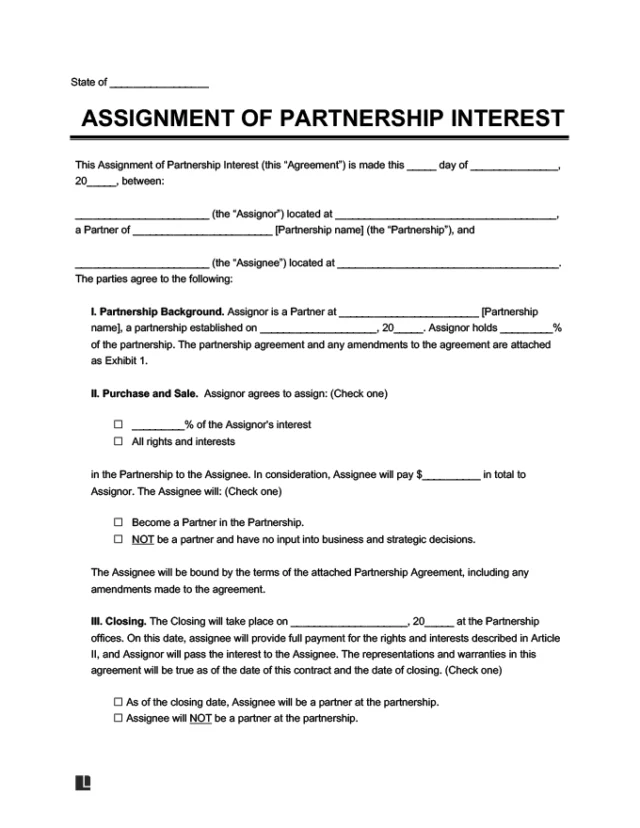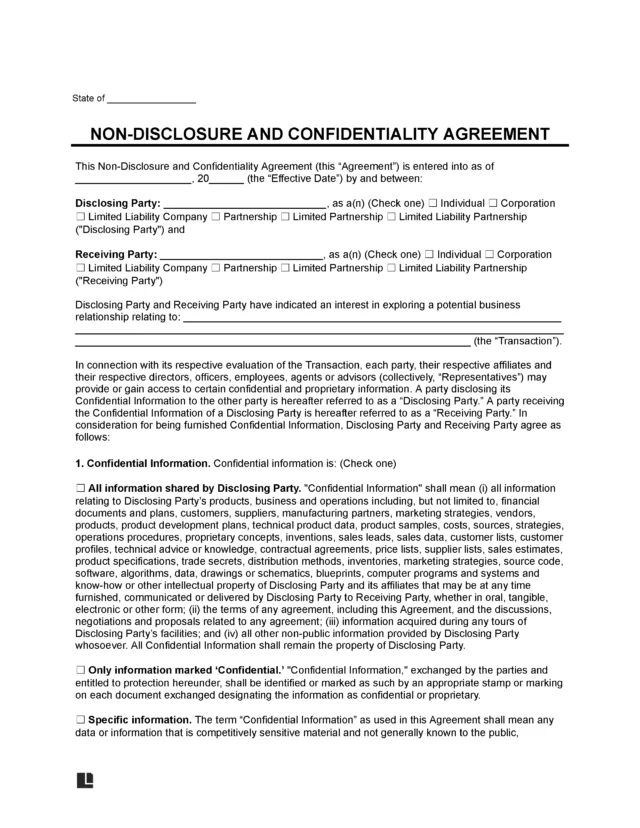What Is a Partnership Dissolution Agreement?
A partnership dissolution agreement outlines the terms under which partners agree to end their arrangement. It helps settle financial obligations and distribute assets among the partners.
This document provides clarity and protects all parties involved during dissolution. They can use it to avoid disputes as they terminate the business relationship.
Other names that refer to a partnership dissolution agreement include the following:
- Business partnership termination agreement
- Dissolution agreement for business partners
- Partnership breakup agreement
- Partnership exit agreement
- Partnership termination contract
When to Use a Business Partnership Dissolution Agreement
You can use a dissolution agreement to end any partnership, whether it’s limited, limited liability, 50/50, real estate, or another type. Specific instances that may result in the need for a dissolution agreement include the following:
- Desire to end the business: The partners may no longer want to be responsible for running their business.
- Partner’s exit: If one partner departs but the other stays, the agreement defines exit terms. If a co-owner wants to sell their shares, they might need a buy-sell agreement instead.
- Disagreements: If partners have unresolved conflicts, a dissolution contract can create an organized end.
- Structure change: Partners may dissolve their business if they want to switch to a different structure, like an LLC.
- Goal achievement: Partnerships with specific goals may reach a natural end.
- External factors: Legal issues, such as disagreements or financial strains, can necessitate dissolution.
- Partner’s incapacity: The partnership may dissolve if a partner cannot contribute, due to death or incapacity, especially if no initial provisions cover such events.
Transferring Business Ownership
If you need to transfer business ownership instead, read our guide on how to transfer business ownership.
Requirements for a Partnership Dissolution Agreement
Signing a partnership dissolution agreement doesn’t instantly conclude the partnership. Partners must follow specific steps to end the arrangement legally.
Each state has its unique approach to dissolution. Texas, for instance, adheres to its specific partnership law (TX Bus Orgs § 11.057). However, partners operating in most states can follow these steps for business dissolution:
- Research specific requirements. Visit your state’s Secretary of State website and study its laws to understand the procedures.
- File documents. Submit a statement of dissolution, often known as “articles of dissolution” or “certificate of cancellation.”
- Complete additional forms. Depending on the state, you may need to file extra forms, such as a transfer of property report.
- Pay termination fees. Be prepared to pay any applicable termination fees as mandated by state law.
- Issue notice. State laws often mandate publishing a public notice for partnership dissolution. However, you might also need to notify specific third parties, such as clients, suppliers, and creditors.
State Tax Requirements When Dissolving a Partnership
Complete your partnership’s final state tax return and settle any remaining taxes, including sales tax, with the respective state and local tax authorities.
IRS Requirements
The Internal Revenue Service (IRS) has specific criteria for closing a business. Here’s what to consider to meet these obligations:
- Submit Form 1065 to the IRS. File Form 1065 (US Return of Partnership Income) with the IRS.
- Mark as “final return.” Ensure you check the “final return” box.
- Complete personal reporting. As partnerships operate as pass-through entities, remember to document any final income and distributions on your individual tax return.
Other Requirements
Dissolving a partnership can take one month or longer, allowing partners enough time to finalize the necessary dissolution tasks. Here are the most common ones:
- Permits and licenses: Cancel all business-related permits, licenses, and registrations.
- Financial matters: Close any bank accounts associated with the partnership.
- Taxes and debts: Ensure all outstanding taxes are paid and debts are settled.
- Contract review: Scrutinize all existing contracts, leases, and other agreements, renegotiating as required.
- Asset management: Proceed with the liquidation or refinancing of partnership assets.
- Asset distribution: Fulfill any buyout amounts as stated in the contract.
How to Write a Partnership Dissolution Agreement
A well-written partnership dissolution agreement helps partners cease operations in an organized manner. Learn how to write one below.
1. Name the Partners
Begin by naming the partners. Specify whether they’re individuals or entities and indicate how you want to abbreviate their names. Include their addresses as well. Legal Templates’s form lets you list up to four partners for your convenience.
2. Describe the Original Partnership
Provide the following information about the original partnership to clarify the business you’re dissolving:
- Name
- Date it was entered into
- Purpose
- State it’s registered in
3. Include Details About the Dissolution Vote
Provide details about the dissolution to show it has majority support. Include the following details:
- The date the dissolution was decided on
- The percentage of members who voted for the dissolution
- The reason for dissolution
- A reference to the applicable section of the original contract that supports the dissolution
A solid reason can prevent disputes and prove that the partnership ends for reasons justified in the original agreement.
4. Allocate Liabilities
Your partnership may have outstanding liabilities, such as bank loans, unpaid wages, and legal claims. List all liabilities and specify which partner will receive them. Describe each item and provide its respective value.
5. Distribute Assets
After paying off obligations, your partnership may have remaining assets. These assets may include cash, accounts receivable, and investments. Describe each asset, list its respective value, and specify which partner will receive it.
6. Include Final Details
Finalize your contract by including a dispute resolution method. Choose the method that works for both parties:
- Court litigation
- Arbitration
- Mediation
- Mediation then arbitration
Include an effective date for the agreement and collect all partners’ signatures to formalize it.
What to Include in a Partnership Dissolution Agreement
In addition to the above details, a dissolution of partnership agreement template has other clauses to round out the contract:
- Winding-up process. Outlines the final accounting steps for closing a partnership.
- Termination of authority. Clarifies that both partners will lose their ability to act on the partnership’s behalf.
- Liquidation of partnership assets. Explains how business assets will be sold or distributed.
- Tax compliance and filings. Covers filing of final state and federal tax returns.
- Allocation of liquidation expenses. Specifies how closing costs and debts will be divided.
- Mutual release. Ensures partners agree not to make future claims against one another.
- Severability. States that if one clause is invalid, the rest of the contract still stands.
Partnership Dissolution Agreement Sample
View our free partnership dissolution agreement template to see how to structure your contract and end your business arrangement. Create your own using our guided form and download it in PDF or Word format.







